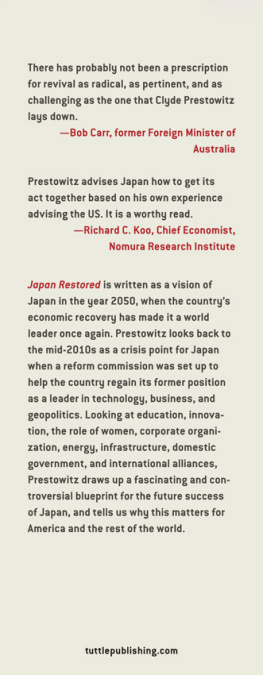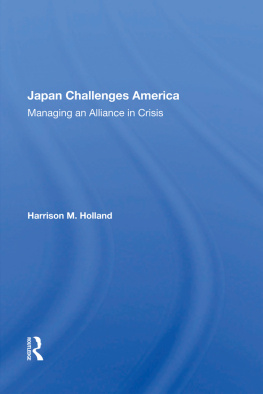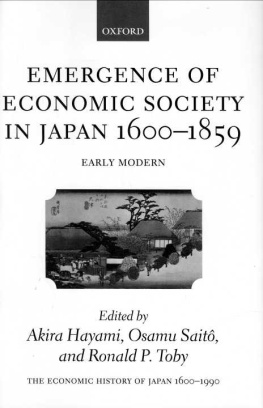Acknowledgments
S pecial thanks to Hiromi Murakami and William (Bill) Finan. Indeed, the book was originally Bills idea, which quickly generated strong support from Hiromi. Both of them assisted greatly with the conceptualization, research, fact checking, and editing of the book. My long time friends Ayako Doi and Henry Marini contributed essential advice and encouragement. Oriental Economist editor Richard Katz kindly provided key statistics and ideas. Long time friend Kyoko Hattori was, as always enthusiastic and cheerful and generously provided her home and facilities for my use. I want to thank Professor Ed Lincoln, Sakie and Glen Fukushima, Arnie Nachmanoff, Ira Wolf, Richard Koo, Pat Mulloy, Dana Marshall, Jim Fallows, Karl van Wolferen, Steve Olson, and Mindy Kotler for their interest and help.
Last, but certainly far from least, I want to thank my long-suffering wife, Carol, who as always provided research and editorial support, patience, encouragement when needed, and discipline when absolutely necessary.
CHAPTER 1
Tokyo, 2050
I ts spring 2050, and youre embarking on a business trip to Tokyo, a city you havent visited for thirty-five years. You board your All Nippon Airlines flight in Washington, DC, and after a smooth ride of about two and a half hours find your Mitsubishi 808 supersonic jetliner circling Haneda Airport in preparation for landing.
Though it is not the worlds first supersonic jetliner, the 808 is almost twice as fast as the Anglo-French Concorde of the 1970s, carries more than three times the Concordes passenger load, and has almost three times the Concordes range. Made of carbon nanofiber and the most advanced electronics, the plane and all its components were entirely developed in Japan after Mitsubishi Heavy Industries acquired Boeing in 2020. This occurred as a result of Boeings bankruptcy in the wake of the continuing fires and groundings of its 787 Dreamliner, which many analysts had waggishly come to label the Nightmare Liner. Now all of the worlds major airlines depend on the 808 for their long-range flights. Exports of this plane, which is made only in Japan, have helped drive the Japanese trade surplus back to levels last seen in the 1980s.
As the flight settles into its landing pattern, you see spread out below one of the worlds most advanced and convenient airfields. Haneda long ago replaced Narita Airport as Tokyos main gateway, and visitors immediately fall in love with it because of its user-friendly systems and the fact that it lies within only thirty minutes of downtown. There is no need for passport or customs control because your travel documents have already been scanned on the plane and reviewed electronically during your flight. After deplaning, you are met by luggage-carrying robots programmed to recognize you as the owner of the suitcases; they accompany you to the train or intelligent vehicle terminals you have preselected.
Here is where you truly make first contact with modern Japan. There are no limousine buses and no taxis with drivers from the airport to downtown Tokyo and other destinations. Rather, there are only robot-driven high-speed trains and driverless vehicles to transport each passenger or group of passengers. No one drives in Japan any longer; the vehicles are all smart, as are the roadways and buildings. A passenger simply steps into a vehicle and tells it the desired destination. The vehicle then automatically moves the passenger to the destination via the fastest route at that particular time. Thanks to these innovations, there are virtually no transportation-related accidents and thus no transportation-related injuries or deaths in Japan anymore.
Smart transport is safe, but also inexpensive, because Japan has developed a variety of low-cost wind, photovoltaic, ocean current, and methane hydrate energy sources and energy-storing devices, linking them all together in a country-wide smart electrical distribution grid. This has reduced the cost of electric-power generation to almost nothing, far below the cost of Japans former outdated mix of nuclear and fossil-fuel power plants.
As the vehicle quietly enters the outskirts of Tokyo, you are surprised at the height of the buildings. Because of the instability of much of the land of Japan due to the prevalence of earthquakes, Tokyo had always been a relatively low-rise city. Of course, advances in earthquake-resistant construction had enabled the construction of skyscrapers there beginning in the 1970s. But Tokyo did not then go on to develop a skyline like those of New York and Hong Kong. Now that has changed. Always the leader in earthquake-proof building designs, Japan has pushed its metallurgical and structural technology for dealing with earthquakes to even higher levels, so that the risk of earthquake damage to buildings in the Tokyo area is virtually nonexistent. But even more important has been Japans development of the carbon-fiber-based UltraRope technology. First introduced by Finnish elevator-maker Kone in 2012, and then further advanced by Japans carbon-fiber and heavy equipment makers, this technology has created cables that are one-seventh the weight of conventional steel cables. Before UltraRope was developed, skyscrapers required riders to change elevators once or twice in going to the top of the building. The extra elevators also made the buildings heavy and thereby limited their height because of pressure on the foundations. The UltraRope cables allow elevators to rise more than a kilometer in a single run, making lighter buildings possible. This has led to the construction in Tokyo of a multitude of office and apartment buildings higher than Dubais Burj Khalifa, which was the worlds tallest building in 2015.
Not only has this allowed for more efficient use of space and more comfortable office and living arrangements, it has also resulted in numerous unexpected economic benefits. Greater urban density, as it turns out, fostered a smart city environment that stimulated entrepreneurial activity, which in turn led to more and faster innovation. Of course, other cities around the world have followed Tokyo in building taller structures, but Japan is the global center of advanced structural design and know-how. Its engineering and construction companies are in great demand worldwide, acting as the leaders for most of the worlds major engineering and construction projects.
Upon arrival at the designated hotel, you are greeted in impeccable, unaccented international English by the staff. (This is just a small piece of evidence that Japan has become a fully bilingual country, in which all students must master English as a condition for graduation from high school and for obtaining a job. You also quickly note that many television and Internet broadcasts carry English subtitles, and that many programs are broadcast in English with Japanese subtitles.) You are guided immediately to your room without going through any check-in proceduresthose have all been handled electronically from your vehicle while you were en route from the airport.
Indeed, to say everything has been handled electronically may give a false impression. As far as the individual is concerned, it would be more accurate to say that everything is handled verbally. Japanese electronics, telecommunications, and software industries have evolved to the point at which people can simply give verbal commands, statements, or queries to ubiquitous smart devices that perform the necessary and requested operations. People wear watches or other jewelry with embedded electronics and voice-recognition capability. These devices communicate with enormous networks that link vast clouds of databases and hypercomputers. Needless to say, the development of all these capabilities has required the invention of completely new materials, industrial processes, sterile environments, tools, communications technologies, and much more. Of course, Japan is not the only country with such capabilities, but it is where most of them were invented or developed, and where they are the most advanced and the most numerous.











